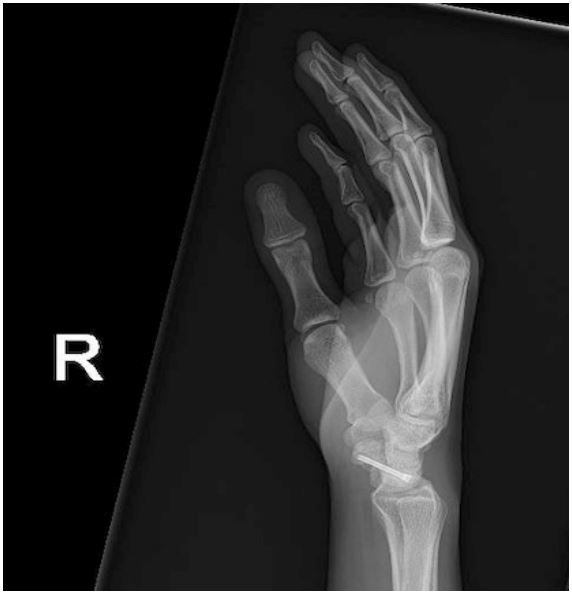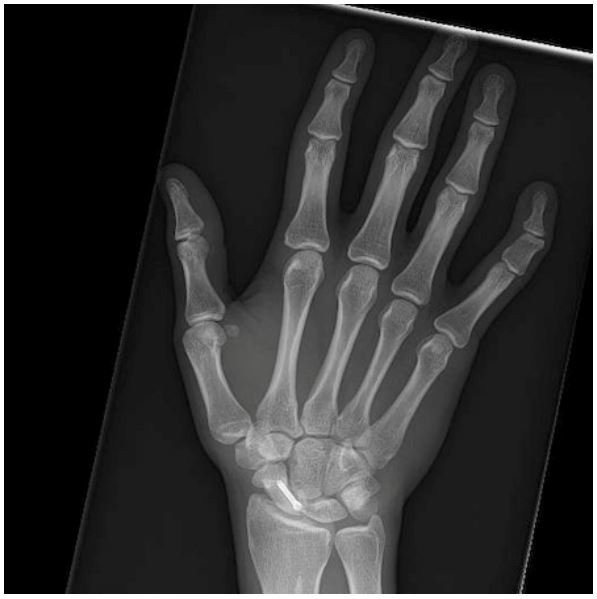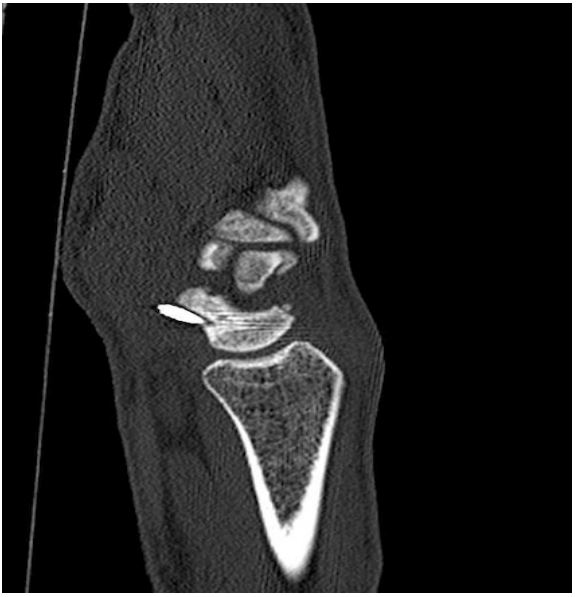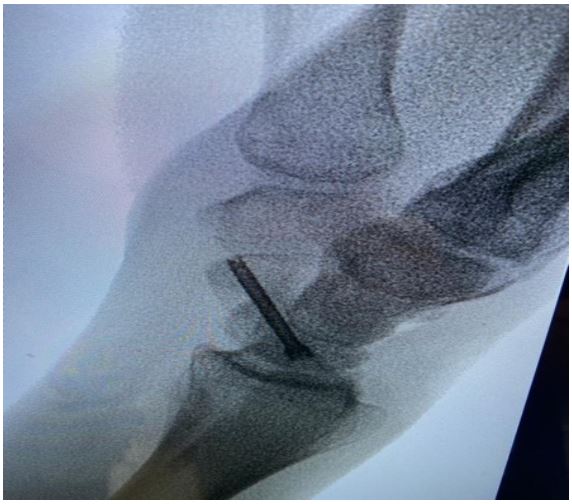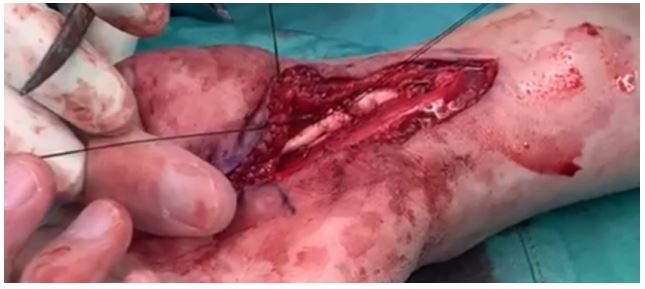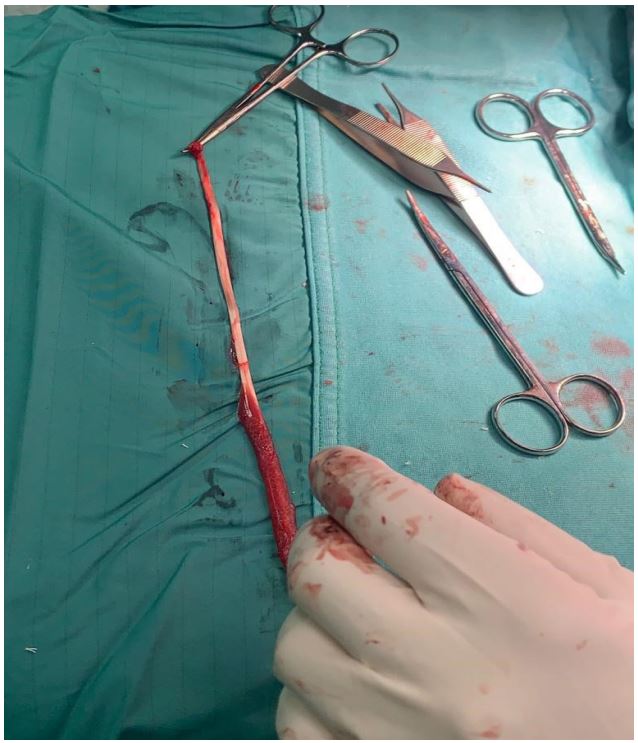Introduction
The scaphoid is the most fractured carpal bone, accounting for
80-90% [4] of all carpal injuries and occurring most commonly in
young, adult males [5]. Postoperative complication include failure: i.e., nonunion, and symptomatic hardware. No data suggests
FPL attritional tear as a complication. FPL attritional tear is relatively uncommon condition. It is associated with repetitive strain,
overuse injuries and degenerative changes within the tendon.
Typical presentation includes sudden pop sensation, pain, and absence of thumb IPJ flexion.
Case presentation
A 23-year-old patient arrived at the clinic following right hand
trauma. A displaced scaphoid waist fracture was diagnosed, and
the patient underwent mini-open fracture reduction and fixation
with headless compression screw. The post-operative period was
unremarkable. 18 months after surgery the patient complained
sudden inability to flex the thumb following a strenuous activity. On physical examination he was not able to actively flex his
right thumb interphalangeal joint. A computer tomography scan
showed a scaphoid screw cut-out (Figure 1-3) with full union of
the fracture. Ultrasonography confirmed a complete tear of the flexor pollicis longus tendon. The patient underwent a revision
procedure with WALANT anesthesia, in which the hardware was
removed, and FPL tendon was reconstructed using a palmaris longus autograft. Intraoperatively, a volar capsular tear was noted after opening the carpal tunnel (Figure 5), which was caused by the
screw (Figure 4). The proximal and distal stump of the FPL tendon
were inspected and after debridement of non-viable substance,
a 4-centimeter gap remained and required graft reconstruction
(Figure 6). The palmaris longus graft was harvested (Figure 7) and
sutured in a pulvertaft weave configuration. Early active post-op
rehabilitation protocol was started. At 2 months follow-up our patient still complains of some pain and limitation in range of motion.
Discussion
FPL tendon rupture due to distal radius plating is a known
complication. To our knowledge, this is the first reported FPL tear
after scaphoid fracture fixation. Graf and Dorn reported a case
of scaphoid waist pseud arthrosis leading to attrition rupture of
the FPL tendon, tenosynovitis, and hemorrhage into the carpal
tunnel, causing symptoms of CTS [6]. In previous reports the palmaris longus grafting was most often utilized, followed by tendon
transfer (about 37%). Primary end-to-end repair, digital joint arthrodesis, FPL tenodesis, and alternative grafting options were
also reported [7].
Our patient was diagnosed in the acute phase and so, we chose
to reconstruct the tendon, assuming the motor unit is still viable.
The Soong classification offers guidance for distal radius volar
plates with intention to prevent post-operative tendon ruptures.
When placing a scaphoid screw, 4 views are utilized to ensure proper placement: PA, Lateral, Pronated oblique, Supinated
oblique. In our case, all intraoperative views confirmed a satisfactory screw position. It is possible that the RF underestimate the
true position or that the screw migrated afterwards. Interestingly,
a follow-up CT scan 2 months after surgery showed union with
proper screw placement.
References
- Monaco NA, Dwyer CL, Ferikes AJ, Lubahn JD. Hand Surgeon Reporting of Tendon Rupture Following Distal Radius Volar Plating. Hand (NY). 2016; 11(3): 278-286. doi: 10.1177/1558944715620792.
- Asadollahi S, Keith PP. Flexor tendon injuries following plate fixation of distal radius fractures: a systematic review of the literature. J Orthop Traumatol. 2013; 14(4): 227-34. doi: 10.1007/s10195-013-0245-z.
- Kanaya K, Kanaya K, Iba K, Yamashita T. Attrition Rupture of the Flexor Pollicis Longus Tendon after Arthrodesis of the Trapeziometacarpal Joint: A Case Report. Hand Surg. 2015; 20(3): 474-6. doi: 10.1142/S0218810415720235.
- Leslie IJ, Dickson RA. The fractured carpal scaphoid. Natural history and factors influencing outcome. J Bone Joint Surg Br. 1981; 63-B(2): 225-30. doi: 10.1302/0301-620X.63B2.7217146.
- Brogan DM, Moran SL, Shin AY. Outcomes of open reduction and internal fixation of acute proximal pole scaphoid fractures. Hand (NY). 2015; 10(2): 227-32. doi: 10.1007/s11552-014-9689-8.
- Graf P, Dorn W. Akutes Karpaltunnelsyndrom und Ruptur der Sehne des M. flexor pollicis longus als seltene Komplikation einer Skaphoidpseudarthrose. Fallbericht Acute carpal tunnel syndrome and tendon rupture of the long flexor muscle of the thumb as a rare complication of a scaphoid pseudoarthrosis. Case report. Handchir Mikrochir Plast Chir. 1990; 22(5): 261-3.
- Monaco NA, Dwyer CL, Ferikes AJ, Lubahn JD. Hand Surgeon Reporting of Tendon Rupture Following Distal Radius Volar Plating. Hand (N Y). 2016; 11(3): 278-286. doi: 10.1177/1558944715620792.

